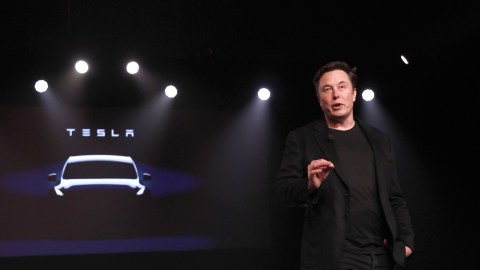Elon Musk promises fleet of 1 million Tesla ‘robotaxis’ in 2020

Patrick T. Fallon/Bloomberg via Getty Images
- Tesla held an investor event on April 22, during which CEO Elon Musk promised the company will soon roll out a robotaxi network to rival companies like Uber and Lyft.
- Some experts say Tesla is overselling its ability to provide truly autonomous vehicles.
- About 71 percent of Americans are still fearful of self-driving cars, up 8 percentage points from 2017.
At an investor event on April 22, Tesla CEO Elon Musk made a characteristically bold promise: By 2020, the company will have a fleet of 1 million fully autonomous cars as part of a “robotaxi” network.
“I feel very confident predicting that there will be autonomous robotaxis from Tesla next year — not in all jurisdictions because we won’t have regulatory approval everywhere,” Musk said. “From our standpoint, if you fast forward a year, maybe a year and three months, but next year for sure, we’ll have over a million robotaxis on the road.”
Tesla owners will be able to earn money by making their cars available on a ride-hailing app similar to Uber, Musk said. The company would take a cut of the revenue – maybe 25 or 30 percent – and would also provide cars itself in areas where not enough people own Teslas.
The timeline is ambitious and potentially unrealistic, considering none of Tesla’s cars are currently fully autonomous. Of course, much of the public thinks such fully self-driving are available right now. One reason? Tesla has long offered a “full self-driving capability” feature that’s not yet a full self-driving feature; it can perform minor driving tasks, like guiding the car to an on-ramp, on its own, but can’t yet provide Tesla owners a fully hands-off autonomous experience.
Tesla removed this feature from its website in October 2018, saying it was causing too much confusion. In February, Tesla reinstated the option, and last week Musk said that all “Tesla cars being produced right now have everything necessary for full self-driving,” adding that the cars would receive this capability through future software updates, which cars can receive without any needing any updates to the existing hardware. (That’s provided the cars have Hardware 3 installed; Tesla said it plans to install the new hardware for free in cars owned by customers who had purchased the full self-driving feature.)
Still, some experts say it’s an unrealistic promise that’s perpetuating consumer confusion.
“Claiming its vehicles will soon be ‘feature complete’ for full self-driving is one more step in the unconscionable practices that Tesla is already engaged in with Autopilot — overselling its capabilities and reliability when marketing its vehicles and then blaming the driver for not reading the manual and paying constant attention when the technology inevitably fails,” Dean Pomerleau, of Carnegie Mellon University, who once rode in a minivan that steered itself across the U.S., told CNN.
Are Americans ready to ride in self-driving cars?
Even if Tesla sticks to its ambitious timeline, it’s unclear how many Americans will be willing to ride in autonomous cars. According to the latest American Automobile Association survey, 71 percent of Americans fear autonomous vehicles, which is about the same number as last year, and up eight percentage points from 2017.
Why is public fear increasing even though self-driving technology is ostensibly improving? It might be due in part to widely covered accidents involving autonomous cars in the past several years, suggested Greg Brannon, AAA’s director of automotive engineering.
“It’s possible that the sustained level of fear is rooted in a heightened focus, whether good or bad, on incidents involving these types of vehicles,” Brannon said in a statement. “Also it could simply be due to a fear of the unknown.”





